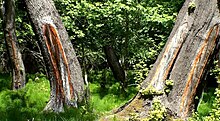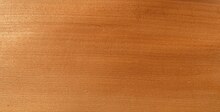Sweetgum trees
| Sweetgum trees | ||||||||||||
|---|---|---|---|---|---|---|---|---|---|---|---|---|

|
||||||||||||
| Systematics | ||||||||||||
|
||||||||||||
| Scientific name | ||||||||||||
| Liquidambar | ||||||||||||
| L. |
The sweetgum trees ( Liquidambar ) are a genus of plants in the small family of Altingiaceae .
Surname
The botanical genus name is derived from the Latin word liquidus for liquid and the Arabic word anbar عنبر for amber . The name Liquidambar means liquid amber, whereby amber is fossil tree resin . The Arabic name anbar became Middle Latin ambar , Middle French ambre and English amber equal to amber.
use
Resin, stems, leaves and fruits are used medicinally.
A resin known as Styrax is extracted from some species and is used for incense . The trees are often incorrectly referred to as Storax trees or Styrax . This is due to the fact that up to the 18th century the resin was mainly obtained from the Storax tree ( Styrax officinalis ), after that mostly from the oriental sweetgum tree ( Liquidambar orientalis ) , which is very similar in odor to the real Storax, but is not closely related . This grows in southern Asia Minor , on the island of Rhodes , but especially in Syria .
An original species of the genus grows in eastern North America from New York to Guatemala and Honduras in Central America ( Liquidambar styraciflua ), which is also used for resin extraction. Many varieties of this variety are known under the name American sweetgum .
description


Liquidambar species grow as deciduous trees and reach heights of 20 to 40 meters, sometimes up to 45 meters. Plant parts can have simple hairs (trichomes). The bark is gray-brown.
The alternate leaves arranged on the branches are divided into a petiole and a leaf blade. The petiole is relatively long. The leaf blade is maple-like, three-, five- or seven-lobed (sometimes with more lobes) or they are rarely simple. The leaf margin is sawn. The linear stipules are more or less fused with the base of the petioles and leave narrow scars when they fall off early.
Liquidambar species are single sexed ( monoecious ). The inflorescence stems are long and thin. The unisexual flowers are without a flower cover . The male, little head-like flowers with bracts sit jointly in traubig- ährigen inflorescences. They fall off quickly after the anthesis. The mostly spherical, female inflorescence is actually a clustered panicle , a head and mostly has sloping bracts . The male flowers have some stamens , the stamens and the egg-shaped anthers are about the same length. The female flowers usually contain Staminodien formed as flakes or teeth around the Gynözeum and a half to under permanent ovary with many ovules , of which only the lowest fertile are. The styles with long stigmas are also recognizable on the ripe fruits. To the upper, free part of the ovary around are also fleshy and reduced to pfriemliche structures ( Phyllome , Pappilae) formed.
The spherical fruit associations contain many woody, septicidal capsule fruits that open with two flaps. The pericarp is thin. Each capsule contains many seeds, many of which are sterile, small, and irregularly angular. The much larger, fertile seeds are ellipsoidal, somewhat compressed and have membranous wings. The seed surface is structured like a network. The endosperm is thin, the embryo is straight.
The chromosome numbers are 2n = 30, 32.
distribution
The genus Liquidambar has a disjoint area : on the one hand in eastern Asia (two in China, one of which occurs only there) and in southwestern Asia (Turkey and Rhodes), on the other hand in Central and North America.
The genus Liquidambar has been proven to be fossilized since the Tertiary , for example in the brown coal deposits of Germany. The species Liquidambar lievenii is known from the Garzweiler opencast mine from the Pliocene at an age of approx. 5 million years .
In Germany, only the American sweetgum tree ( Liquidambar styraciflua ) is frost and winter hardy. The American sweetgum tree is a large tree between 20 and 45 meters tall and up to 10 meters wide. In addition to mountain elm , common ash, ginkgo , maple-leaved plane , white poplar, summer linden and common oak, it is one of the tallest deciduous trees in Europe. In tree nurseries, you can buy various small tree cultivars and varieties of the American sweetgum tree, also as a standard trunk, e.g. B. the varieties Oktoberglut ( Liquidambar styraciflua 'Oktoberglut' ), which is about 3 m tall, or Gumball ( Liquidambar styraciflua 'Gumball' ) with a spherical crown (also known as the spherical amber tree), which can reach about 5 m.
Systematics
This genus was placed by some authors in the subfamily Liquidambaroideae in the family Hamamelidaceae . The genus name was first published in 1753 by Carl von Linné in Species Plantarum , 2, p. 999. Type species is Liquidambar styraciflua L.
The genus includes about 15 species:
- Liquidambar acalycina H.T. Chang : Native to central and southeastern China .
- Chinese sweetgum, Taiwanese sweetgum or Formosa sweetgum ( Liquidambar formosana Hance ): Native to central and southeastern China, southeastern Korea , Taiwan , Laos and northeastern Vietnam .
- Oriental sweetgum ( Liquidambar orientalis Mill. ): Native to southwestern Turkey and the Greek island of Rhodes .
- American sweetgum ( Liquidambar styraciflua L. ): Native to North and Central America from the USA south to Guatemala and Nicaragua .
swell
- Zhi-Yun Zhang, Hongda Zhang & Peter K. Endress: Hamamelidaceae in the Flora of China , Volume 9, p. 21: Liquidambar - online (section description, systematics).
- Frederick G. Meyer: Hamamelidaceae in the Flora of North America , Volume 3: Liquidambar - online (section description).
- David John Mabberley: The Plant Book. A portable dictionary of the higher plants. Cambridge University Press 1987, ISBN 0-521-34060-8 .
- Walter Erhardt among others: The big pikeperch. Encyclopedia of Plant Names. Volume 2, Verlag Eugen Ulmer, Stuttgart 2008. ISBN 978-3-8001-5406-7 .
Individual evidence
- ↑ Zhi-Yun Zhang, Hongda Zhang & Peter K. Endress: Hamamelidaceae in the Flora of China , Volume 9, p. 21: Liquidambar - online .
literature
- Margaret T. Hoey, Clifford R. Parks: Genetic Divergence in Liquidambar styraciflua, L. formosana, and L. acalycina (Hamamelidaceae). In: Systematic Botany. Volume 19, Number 2 (Apr-Jun. 1994), pp. 308-316.
- A. Linn Bogle: The floral morphology and vascular anatomy of the Hamamelidaceae: subfamily Liquidambaroideae. In: Annals of the Missouri Botanical Garden. 73 (1), 1986, pp. 325-347, online at biodiversitylibrary.org.


